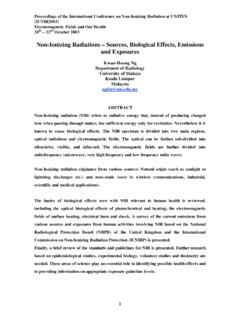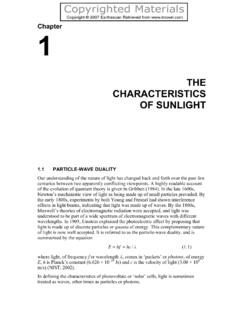Transcription of Energy Storage in the UK
1 Energy Storage in the UKAn Overview2nd Autumn 2016A Renewable Energy Association PublicationTable of ContentsSection 1 Introduction 4 Section 2 Energy Storage Technologies 6 Mechanical Storage 6 Pumped hydro Storage 6 Compressed air Energy Storage 7 Flywheels 8 Electrochemical Energy Storage (batteries) 9 Conventional batteries 9 High temperature batteries 9 Flow batteries 10 Chemical Energy Storage 11 Hydrogen (H2) 12 Synthetic natural gas (SNG) 12 High temperature thermal Energy Storage 12 Thermal Energy Storage (TES)
2 12 Sensible heat Storage 12 Latent heat Storage 12 Thermo-chemical Storage 13 High temperature thermal Energy Storage 13 Pumped heat electrical Storage 13 Liquid air Energy Storage (LAES) 13 electromagnetic Storage 14 Capacitors 14 Superconducting magnetic Energy Storage (SMES) 15 Section 3 Energy Storage Today 17 Energy Storage policies internationally 17 UK Energy Storage projects 20 DNO Low Carbon Network Fund Energy Storage projects 23 Section 4 Industry Interviews 23 Section 5 Conclusions 26 References 27 Annexes
3 293 Section 1 - Introduction The Energy Storage market has moved on since the first version of this REA report was published in autumn 2015, but the underlying drivers remain unchanged - a significant increase in renewable Energy supplies amid growing demand for Energy . At the same time, various factors are putting increasing pressure on the electricity grid network. The landmark EFR contracts (see full list in new Annex C) has kick started the large scale end of the market and turned the eyes of the world on UK Energy Storage providers. Energy Storage (ES) technologies offer great potential for supporting renewable Energy and the UK s Energy system.
4 In 2014 the then Department for Business, Innovation and Skills (BIS) named Storage as one of eight great technologies the UK can be world leaders in , progress has been made but clearly more action is needed to reach this potential. Many of the benefits, and possible cost trajectories for key technologies, are summarised in an REA commissioned KPMG report from early 2016 (see KPMG, 2016). Storage technologies are able to absorb and release Energy when required and provide ancillary power services which help benefit the power system. The Storage industry can therefore deliver tremendous benefits for system stability and security of supply as well as helping to decarbonise UK Energy supplies.
5 Storage technologies offer flexibility during times of fluctuating Energy generation and demand, which make Energy Storage technologies an important part of a low carbon future network. In addition, there are significant economic benefits - if 2GW of Energy Storage was deployed by 2020 the industry could create jobs for up to 10,000 people in the UK (Strbac, et al., 2012). The landmark National Infrastructure Commission Report Smart Power projected a possible 8 billion saving to the UK, per year, by 2030 if Storage and flexibility measures are introduced on a large scale. This also highlights the role of Energy Storage as one of a range of measures for increasing flexibility.
6 The REA sees Energy Storage as a key missing piece of the UK s Energy policy. Storage can help deliver the low carbon Energy the country needs and it is therefore vitally important that it is appropriately incentivised and supported. The REA launched the UK Energy Storage group to help the industry reach its potential and this has now grown to over 100 member companies active across a range of technologies and scales. Storage technologies can be deployed at different scales on a distributed and/or centralised basis. The development of Energy Storage technologies vary across the industry, while some are quite mature others are still in their development stages.
7 There is significant investment in Energy Storage around the globe and we are now in something of a technology and deployment race. For the Energy Storage industry to develop and the UK to gain the huge benefits possible as a result, the Government, grid operators, industry and stakeholders need to work together to take aim of this report is to increase knowledge of the industry among various report encompasses an updated summary of the current technologies; support available internationally for Storage technologies; Energy Storage projects deployed at present in the UK; and a discussion of the current key issues for the sector, before offering some report also includes an updated list of operational UK Energy Storage projects (section ) and successful EFR projects (Annex C) as of autumn of Energy StorageThere are a number of benefits Energy Storage can offer in various forms and to various stakeholders, these include; Energy Storage can enable the integration of more renewables (especially solar PV and wind) in the Energy mix.
8 Storage technologies could decrease the need to invest in new conventional generation capacity, resulting in financial savings and reduced emissions especially from electricity generation. Storage technologies improve our Energy security by optimising the supply and demand, thus reducing the need to import electricity via interconnectors. They can also provide system stability during electricity outages by supplying Energy at these times and reducing the financial costs of power outages. Utilisation of Storage also means fewer and cheaper electricity transmission and distribution system upgrades are required.
9 Energy can be stored when prices are low and used on site when they are high to save consumers and businesses money on their bills. Alternatively the stored Energy can be sold. Large amounts of Energy Storage can significantly reduce Energy loss during transmission and distribution. Electricity transmission losses typically run at just below 10% of the total Energy first produced in the UK (this is formalised in the UK by the application of a transmission loss multiplier to CfD generation of 9%). Storage can provide ancillary services to the System Operator at lower cost, lower carbon intensity than traditional providers such as conventional thermal power plants.
10 Storage technologies can reduce the usage of fossil fuels, enabling a greener, lower carbon Energy supply 2 - Energy Storage Technologies Figure 2-1 Overview of Energy Storage technologies, power and Energy Storage durations (IEC, 2011) Energy Storage technologies are classified according to the form of Energy they use. This section provides short overviews of each technology, using explanations from different sources presented in order to be comparable to each other, (please note that newtechnologies are being developed, however this report necessarily covers only those that are widely used, deployed or close to deployment).











